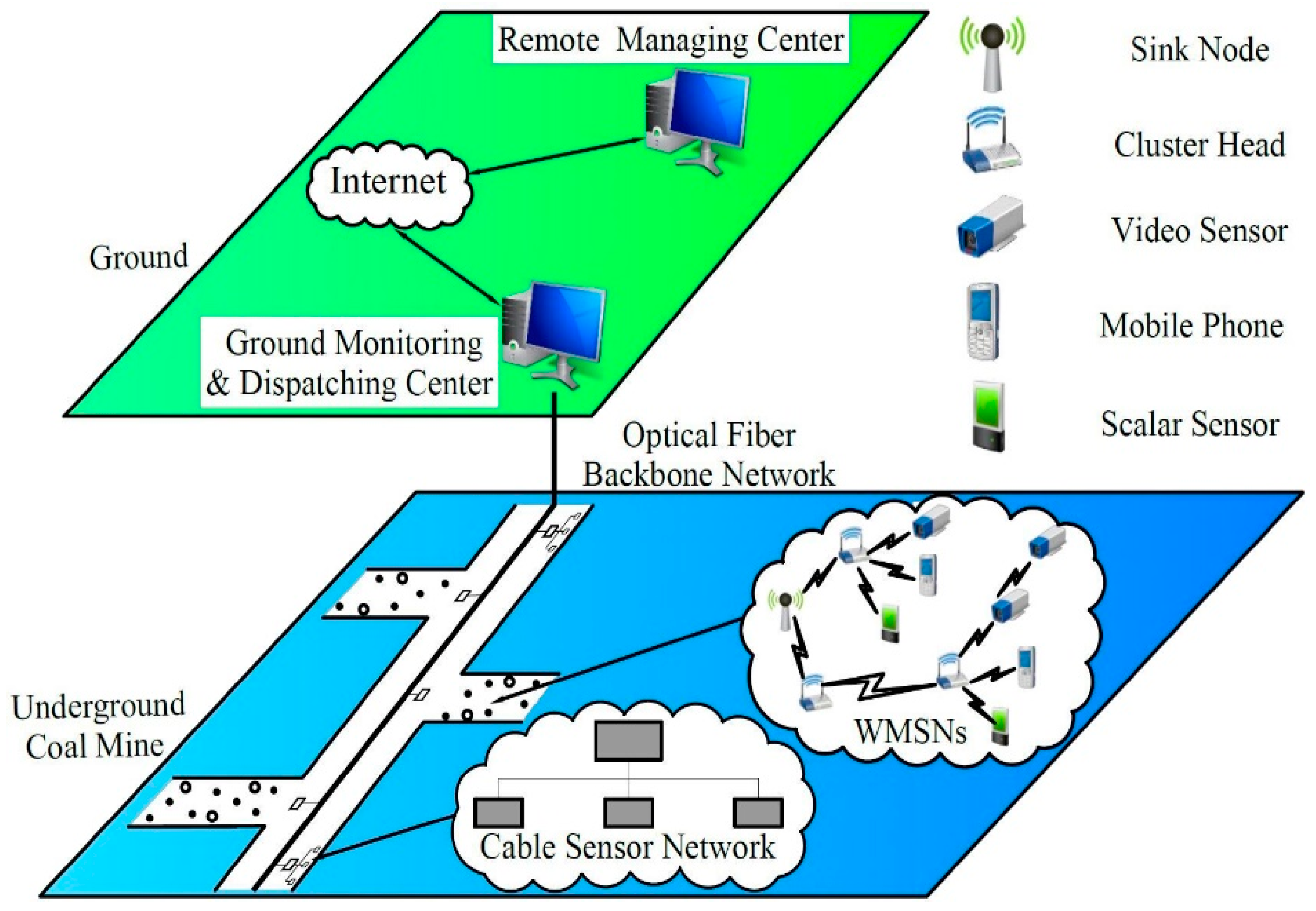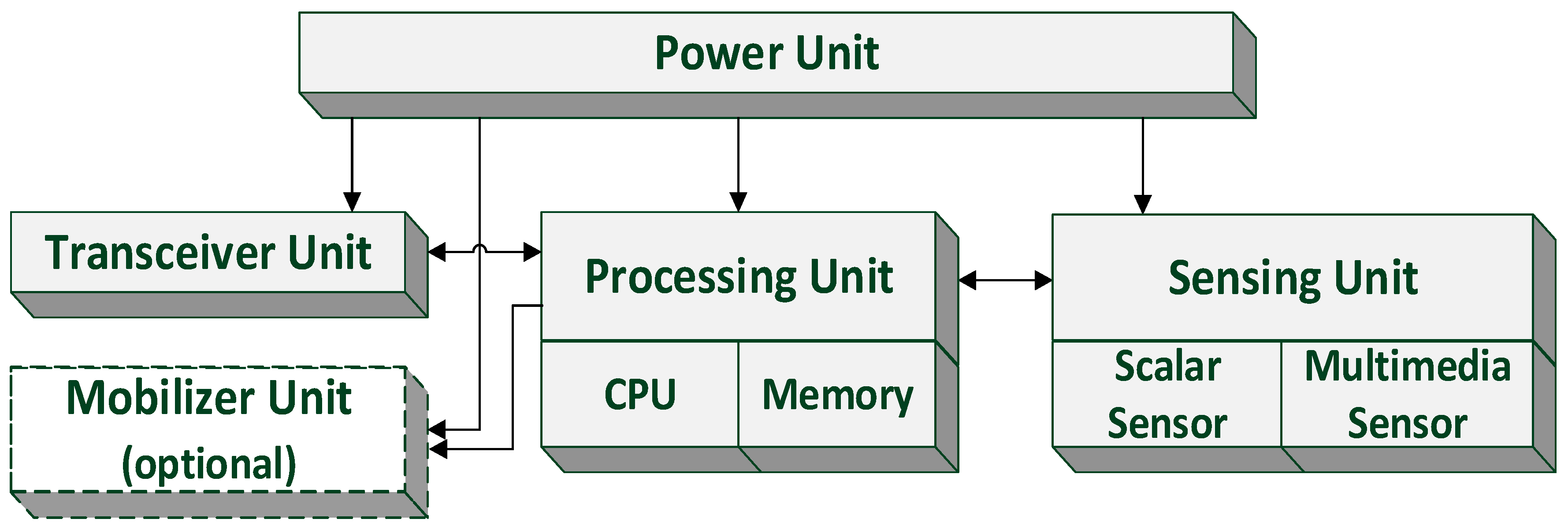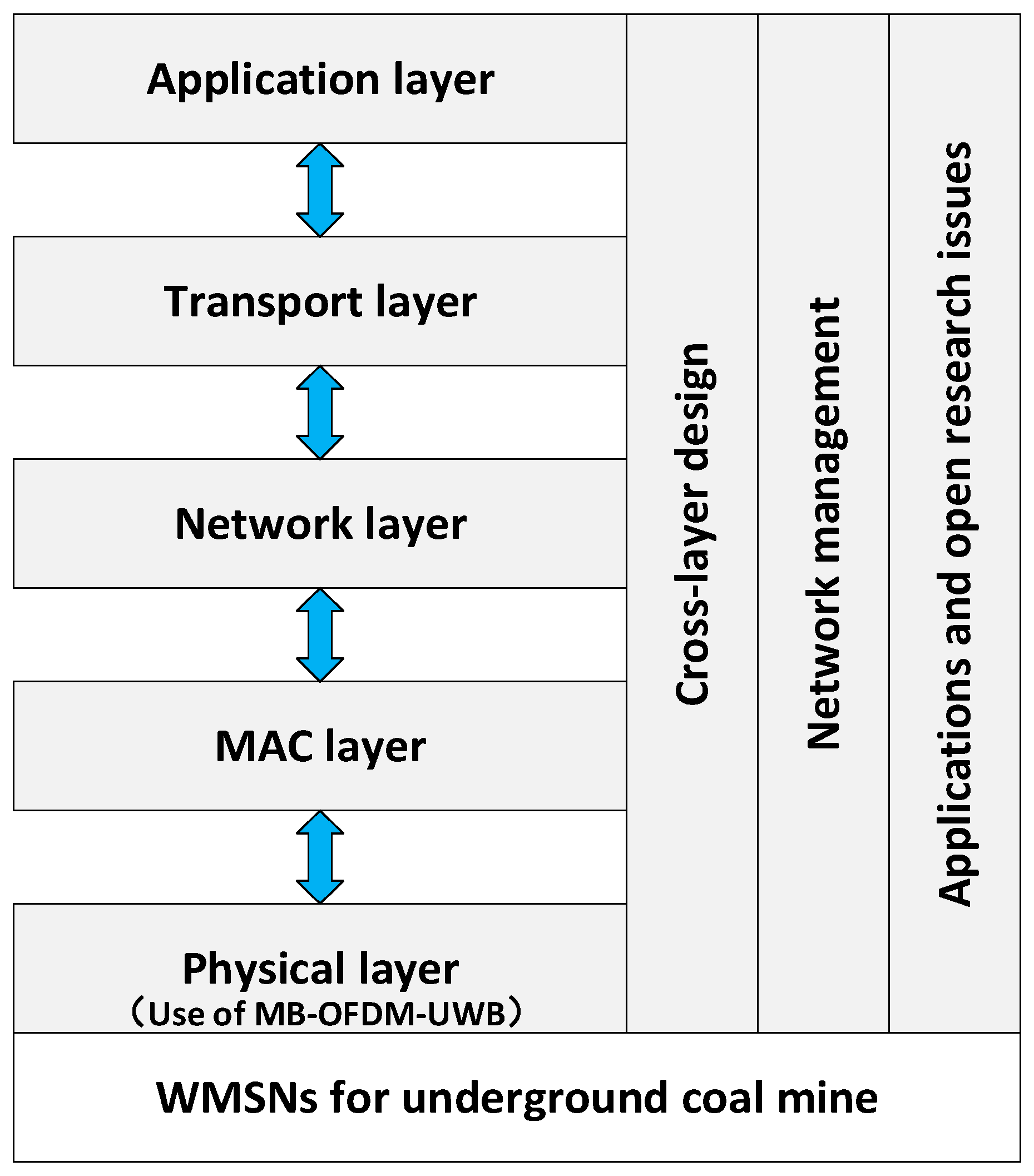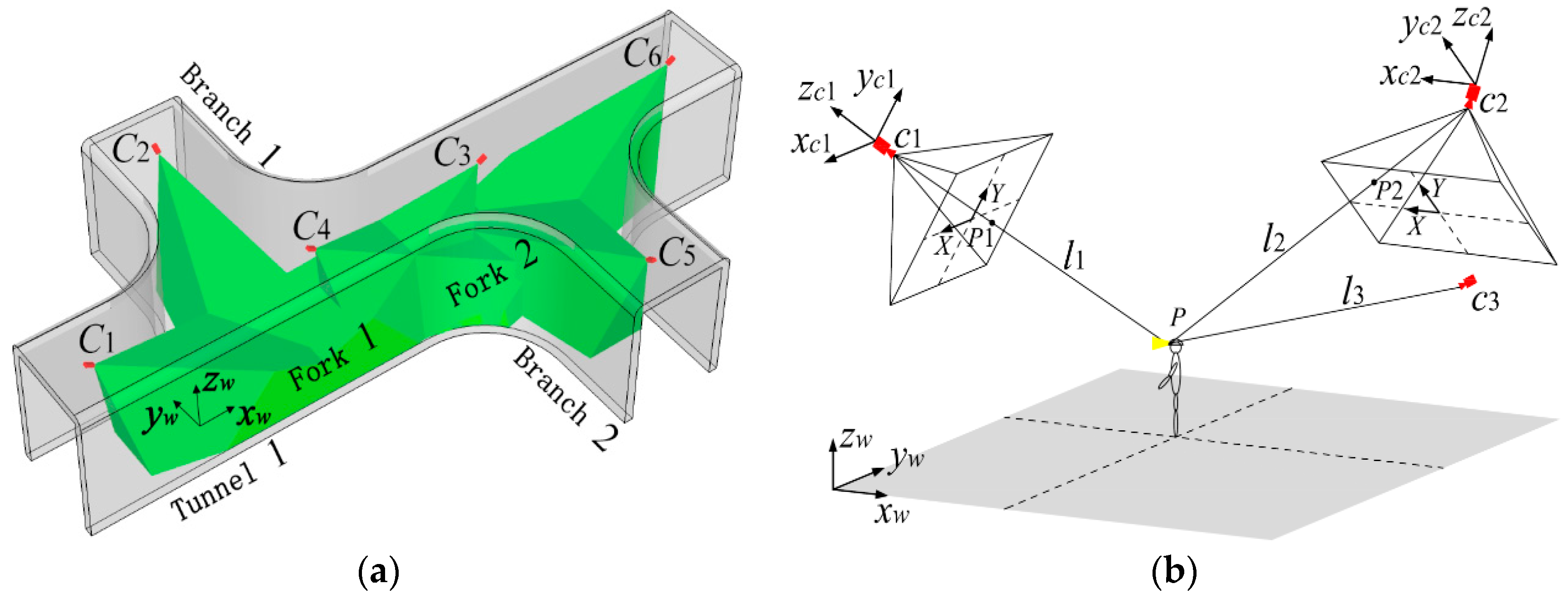MB-OFDM-UWB Based Wireless Multimedia Sensor Networks for Underground Coalmine: A Survey
Abstract
:1. Introduction
2. Overall Design of the WMSNs for Underground Coalmine and Related Works
2.1. Network Structure
2.2. Main Challenges for Designing
3. Key Supporting Technologies for the WMSNs
3.1. Coverage-Enhancing Algorithms
3.2. MAC Protocols
3.3. Routing Protocols
- (1)
- QoS: Most of the routing protocols for traditional WSNs mainly aim at minimizing the energy consumption, but introducing the multimedia contents like videos and images into WMSNs makes QoS a crucial issue. When designing routing protocols, not only the energy consumption, scalability and robustness of the network, but also real-time and reliable transmission of multimedia data need to be taken into consideration.
- (2)
- Sensing models: Sensors in WMSNs are universally directional, e.g., video sensors, which make the sensing models or coverage models distinct from those of traditional WSNs. Distinctions in sensing models or coverage models will directly affect the design of network structure and routing protocols.
- (3)
- Data aggregation: For the sake of reducing the amount of data and lowing power consumption, a majority of the routing protocols for WSNs have adopted data aggregation mechanism. In WMSNs, sensors nodes have strong directionality and transmits multimedia data which are information-rich and time-sensitive. The redundancy and the relevance of multimedia data need to be considered when aggregating data.
3.4. Cross-Layer Design
3.5. Multimedia Encoding in Application Layer
4. Other Research Issues
4.1. UWB Localization
4.2. Target Localization
4.3. Information Processing
4.4. Network Management
5. Discussion for Future Research Directions
6. Conclusions
Acknowledgments
Conflicts of Interest
References
- State Administration of Work Safety; State Administration of Coal Mine Safety. State Technological Development Programming of Work Safety: Coal Mine Domain Research Bulletin (2004–2010). Available online: http://www.chinasafety.gov.cn/file/2004-01/kjgh-3.doc (accessed on 17 May 2016).
- Yang, W.; Feng, X.S.; Cheng, S.X.; Sun, J.P. The theories and key technologies for the new generation mine wireless information system. J. China Coal Soc. 2004, 29, 506–509. [Google Scholar]
- Ma, H.D.; Tao, D. Multimedia Sensor Network and Its Research Progresses. J. Softw. 2006, 17, 2013–2028. [Google Scholar] [CrossRef]
- Akyildiz, I.F.; Melodia, T.; Chowdhury, K.R. A Survey on Wireless Multimedia Sensor Networks. Comput. Netw. 2007, 51, 921–960. [Google Scholar] [CrossRef]
- Akyildiz, I.F.; Melodia, T.; Chowdhury, K.R. Wireless multimedia sensor networks: A survey. IEEE Wirel. Commun. 2007, 14, 32–39. [Google Scholar] [CrossRef]
- Holman, R.; Stanley, J.; Ozkan-Haller, T. Applying video sensor networks to nearshore environment monitoring. IEEE Trans. Pervasive Comput. 2003, 2, 14–21. [Google Scholar] [CrossRef]
- Han, R.S.; Yang, W. A coverage-enhancing algorithm based on improved virtual potential field for WMSN of underground coal mine. J. China Coal Soc. 2015, 40, 959–964. [Google Scholar]
- Han, R.S.; Yang, W. A coverage-enhancing algorithm based on improved particle swarm optimization for WMSN of underground coal mine. J. China Univ. Min. Technol. 2016, 45, 170–175. [Google Scholar]
- Sun, R.K.; Ding, E.J.; Duan, Z. The study of a wireless multimedia sensor network self-organization protocol for coal mine. In Proceedings of the IEEE International Conference on Computer Engineering and Technology, Chengdu, China, 16–18 April 2010; pp. V4-237–V4-241.
- Zhang, G.P.; Wang, Y.F.; Ding, E.J. Study on UWB signal transmitting and receiving strategy of mine wireless multi-media sensor network. Coal Sci. Technol. 2013, 41, 71–75. [Google Scholar]
- Zhang, Y.; Yang, W.; Han, D.S.; Kim, Y.I. An integrated environment monitoring system for underground coal mines—Wireless Sensor Network subsystem with multi-parameter monitoring. Sensors 2014, 14, 13149–13170. [Google Scholar] [CrossRef] [PubMed]
- Hustrulid, W.A.; Bullock, R.C. Underground Mining Methods: Engineering Fundamentals and International Case Studies; SME: Littleton, CO, USA, 2001. [Google Scholar]
- Rabaey, J.M.; Ammer, M.J.; da Silva, J.L., Jr.; Patel, D.; Roundy, S. PicoRadio supports ad hoc ultra-low power wireless networking. Computer 2000, 33, 42–48. [Google Scholar] [CrossRef]
- Kohvakka, M.; Arpinen, T.; Hännikäinen, M.; Hämäläinen, T.D. High-performance multi-radio WSN platform. In Proceedings of the 2nd International Workshop on Multi-Hop Ad Hoc Networks: From Theory to Reality, Florence, Italy, 26 May 2006; pp. 95–97.
- Akyildiz, I.F.; Su, W.; Sankarasubramaniam, Y.; Cayirci, E. Wireless sensor networks: A survey. Comput. Netw. 2002, 38, 393–422. [Google Scholar] [CrossRef]
- Stargate Developer’s Guide. Available online: http://platformx.sourceforge.net/Documents/manuals/StarGateManual7430-0317-11_A.pdf (accessed on 17 November 2016).
- Rahimi, M.; Baer, R.; Iroezi, O.I.; Garcia, J.C.; Warrior, J.; Estrin, D.; Srivastava, M. Cyclops: In situ image sensing and interpretation in wireless sensor networks. In Proceedings of the 3rd International Conference on Embedded Networked Sensor Systems, San Diego, CA, USA, 2–4 November 2005; pp. 192–204.
- Moridi, M.A.; Kawamura, Y.; Sharifzadeh, M.; Chanda, E.K.; Wagner, M.; Jang, H.; Okawa, H. Development of underground mine monitoring and communication system integrated ZigBee and GIS. Int. J. Min. Sci. Technol. 2015, 25, 811–818. [Google Scholar] [CrossRef]
- Bhattacharjee, S.; Roy, P.; Ghosh, S.; Misra, S.; Obaidat, M.S. Wireless sensor network-based fire detection, alarming, monitoring and prevention system for Bord-and-Pillar coal mines. J. Syst. Softw. 2012, 85, 571–581. [Google Scholar] [CrossRef]
- Savazzi, S.; Spagnolini, U.; Goratti, L.; Molteni, D.; Latva-aho, M.; Nicoli, M. Ultra-wide band sensor networks in oil and gas explorations. IEEE Commun. Mag. 2013, 51, 150–160. [Google Scholar] [CrossRef]
- Yang, W.; Wang, B. Realization of hierarchy wireless sensor network for mine laneway monitoring. J. China Coal Soc. 2008, 34, 44–48. [Google Scholar]
- Yang, W.; Zhang, D.Z. Multi-parameters monitoring underground coal mine environments using mesh-structured wireless sensor networks. J. Huazhong Univ. Sci. Technol. 2010, 38, 70–74. [Google Scholar]
- Sun, Y.J.; Qian, J.S.; Wu, J.L.; Luo, Y.G. Research on safety monitor system for underground unmanned roadway based on WSN. Chin. J. Sens. Actuators 2007, 20, 2517–2521. [Google Scholar]
- Zhu, X.J.; Wang, J.H.; Meng, X.R. 3D localization algorithm for wireless sensor networks in underground coal mine. J. Comput. Appl. 2012, 32, 927–931. [Google Scholar] [CrossRef]
- Zhang, J.Y.; Orlik, P.V.; Sahinoglu, Z.; Molisch, A.F.; Kinney, P. UWB systems for wireless sensor networks. Proc. IEEE 2009, 97, 313–331. [Google Scholar] [CrossRef]
- Feng, D.; Lu, L.; Wu, Y.-Y.; Li, G.Y.; Li, S.; Feng, G. Device-to-device communications in cellular networks. IEEE Commun. Mag. 2014, 52, 49–55. [Google Scholar] [CrossRef]
- Lee, J.S.; Su, Y.W.; Shen, C.C. A comparative study of wireless protocols: Bluetooth, UWB, ZigBee, and Wi-Fi. In Proceedings of the 33rd Annual Conference of the IEEE Industrial Electronics Society (IECON), Taipei, Taiwan, 5–8 November 2007; pp. 46–51.
- Moridi, M.A.; Kawamura, Y.; Sharifzadeh, M.; Chanda, E.K.; Jang, H. An investigation of underground monitoring and communication system based on radio waves attenuation using ZigBee. Tunn. Undergr. Space Technol. 2014, 43, 362–369. [Google Scholar] [CrossRef]
- Yarkan, S.; Guzelgoz, S.; Arslan, H.; Murphy, R.R. Underground mine communications: A survey. IEEE Commun. Surv. Tutor. 2009, 11, 125–142. [Google Scholar] [CrossRef]
- Emergency Communication and Tracking Committee. Underground Communication and Tracking Systems Tests at CONSOL Energy Inc., McElroy Mine; Report of Findings; Mine Safety and Health Administration: Arlington, VA, USA, 2006.
- Yue, G.R.; Ge, L.J. Summaries of ultra-wide bandwidth radio. J. PLA Univ. Sci. Technol. 2002, 3, 14–19. [Google Scholar]
- Lee, S.; Jeon, Y.; Choi, S.; Han, M.S.; Cho, K. Gigabit UWB video transmission system for wireless video area network. IEEE Trans. Consum. Electron. 2011, 57, 395–402. [Google Scholar] [CrossRef]
- Gungor, V.C.; Hancke, G.P. Industrial wireless sensor networks: Challenges, design principles, and technical approaches. IEEE Trans. Consum. Electron. 2009, 56, 4258–4265. [Google Scholar] [CrossRef]
- Yang, L.; Giannakis, G.B. Ultra-wideband communications: An idea whose time has come. IEEE Signal Process. Mag. 2004, 21, 26–54. [Google Scholar] [CrossRef]
- Yang, W.; Cheng, S.X.; Sun, J.P. The mine wireless communication and frequency resource utilization. J. China Coal Soc. 2001, 26, 535–538. [Google Scholar]
- Nikookar, H.; Prasad, R. Introduction to Ultra Wideband for Wireless Communications; Springer: Dordrecht, The Netherlands, 2009. [Google Scholar]
- Fan, X.Y.; Yang, W. Study on the adaption modulation of underground mine multimedia wireless sensor network. J. China Coal Soc. 2009, 34, 1291–1296. [Google Scholar]
- Fan, X.Y.; Yang, W. Study on dynamic subcarrier allocation for underground mine multimedia wireless sensor network. J. Beijing Jiaotong Univ. 2009, 33, 50–54. [Google Scholar]
- Huang, C.F.; Tseng, Y.C. A survey of solutions to the coverage problems in wireless sensor networks. J. Internet Technol. 2005, 6, 1–8. [Google Scholar]
- Tao, D.; Ma, H.D. Coverage control algorithms for directional sensor networks. J. Softw. 2011, 22, 2317–2334. [Google Scholar] [CrossRef]
- Ye, W.; Heidemann, J.; Estrin, D. Medium access control with coordinated adaptive sleeping for wireless sensor networks. IEEE/ACM Trans. Netw. 2004, 12, 493–506. [Google Scholar] [CrossRef]
- Lu, X.M.; Shao, S.Y. A novel platform of Coal Mine Monitoring System based on wireless sensor network. In Proceedings of the 2010 IEEE International Conference on Information and Automation, Harbin, China, 20–23 June 2010; pp. 2225–2228.
- He, S.Y. The research of energy efficient MAC protocols in gas monitoring system of mine. In Proceedings of the 2008 International Symposium on Information Science and Engineering, Shanghai, China, 20–22 December 2008; pp. 316–319.
- Hu, Y.J.; Cao, X.D. An adaptive RTS adjustment algorithm for MAC protocol in coal mine. In Proceedings of the 15th Asia-Pacific Conference on Communications, Shanghai, China, 8–10 October 2009; pp. 758–761.
- Saxena, N.; Roy, A.; Shin, J. Dynamic duty cycle and adaptive contention window based QoS-MAC protocol for wireless multimedia sensor networks. Comput. Netw. 2008, 52, 2532–2542. [Google Scholar] [CrossRef]
- Akyildiz, I.F.; Stuntebeck, E.P. Wireless underground sensor networks: Research challenges. Ad Hoc Netw. 2006, 4, 669–686. [Google Scholar] [CrossRef]
- He, T.; Stankovic, J.A.; Lu, C.; Abdelzaher, T. SPEED: A stateless protocol for real-time communication in sensor networks. In Proceedings of the 23rd IEEE International Conference on Distributed Computing Systems, Providence, RI, USA, 19–22 May 2003; pp. 46–55.
- Zhang, L.; Hauswirth, M.; Shu, L.; Zhou, Z.; Reynolds, V.; Han, G. Multi-priority multi-path selection for video streaming in wireless multimedia sensor networks. In Proceedings of the International Conference on Ubiquitous Intelligence and Computing, Oslo, Norway, 23–25 June 2008; pp. 439–452.
- Yao, L.; Wen, W.J.; Gao, F.X. A real-time and energy aware QoS routing protocol for Multimedia Wireless Sensor Networks. In Proceedings of the 7th World Congress on Intelligent Control and Automation, Chongqing, China, 25–27 June 2008; pp. 3321–3326.
- Deb, B.; Bhatnagar, S.; Nath, B. ReInForM: Reliable information forwarding using multiple paths in sensor networks. In Proceedings of the 28th Annual IEEE International Conference on Local Computer Networks, Bonn/Königswinter, Germany, 20–24 October 2003; pp. 406–415.
- Melodia, T.; Akyildiz, I.F. Cross-layer QoS-aware communication for ultra-wide band wireless multimedia sensor networks. IEEE J. Sel. Areas Commun. 2010, 28, 653–663. [Google Scholar] [CrossRef]
- Shah, G.A.; Liang, W.; Akan, O.B. Cross-layer framework for QoS support in wireless multimedia sensor networks. IEEE Trans. Multimed. 2012, 14, 1442–1455. [Google Scholar] [CrossRef]
- Girod, B.; Aaron, A.M.; Rane, S.; Rebollo-Monedero, D. Distributed video coding. Proc. IEEE 2005, 93, 71–83. [Google Scholar] [CrossRef]
- Xiong, Z.; Liveris, A.D.; Cheng, S. Distributed source coding for sensor networks. IEEE Signal Process. Mag. 2004, 21, 80–94. [Google Scholar] [CrossRef]
- HoangVan, X.; Jeon, B. Flexible complexity control solution for transform domain Wyner-Ziv video coding. IEEE Trans. Broadcast. 2012, 58, 209–220. [Google Scholar] [CrossRef]
- Rowitch, D.N.; Milstein, L.B. On the performance of hybrid FEC/ARQ systems using rate compatible punctured turbo (RCPT) codes. IEEE Trans. Commun. 2010, 48, 948–959. [Google Scholar] [CrossRef]
- Slowack, J.; Skorupa, J.; Deligiannis, N.; Lambert, P.; Munteanu, A.; Van de Walle, R. Distributed video coding with feedback channel constraints. IEEE Trans. Circuits Syst. Video Technol. 2012, 22, 1014–1026. [Google Scholar] [CrossRef] [Green Version]
- Zhao, X.H.; Wang, Z.L.; Zhao, K.K. Research on distributed image compression algorithm in coal mine WMSN. Int. J. Digit. Content Technol. Its Appl. 2011, 5, 283–291. [Google Scholar]
- Stoica, L.; Rabbachin, A.; Oppermann, I. A low-complexity noncoherent IR-UWB transceiver architecture with TOA estimation. IEEE Trans. Microw. Theory Tech. 2006, 54, 1637–1646. [Google Scholar] [CrossRef]
- Meng, J.; Zhang, Q.Y.; Zhang, N.T.; Chen, P.; Liu, N.N. Modeling the distance error and performance analysis in IR-UWB positioning system. J. Commun. 2011, 32, 10–16. [Google Scholar]
- Oztarak, H.; Akkaya, K.; Yazici, A. Lightweight object localization with a single camera in wireless multimedia sensor networks. In Proceedings of the GLOBECOM 2009, Honolulu, HI, USA, 30 November–4 December 2009; pp. 1–6.
- Liu, L.; Zhang, X.; Ma, H.D. Optimal node selection for target localization in wireless camera sensor networks. IEEE Trans. Veh. Technol. 2010, 59, 3562–3576. [Google Scholar] [CrossRef]
- Li, J.T.; Jin, Y.X.; Tang, J.; Zhang, Y. Target localization method based on wireless multimedia sensor network. J. Zhejiang Univ. 2011, 45, 45–49. [Google Scholar]
- You, K.M.; Yang, W.; Han, R.S. The Video Collaborative Localization of a Miner’s Lamp Based on Wireless Multimedia Sensor Networks for Underground Coal Mines. Sensors 2015, 15, 25103–25122. [Google Scholar] [CrossRef] [PubMed]
- Tao, D.; Ma, H.D. An image fusion algorithm based on correlation for video sensor networks. J. Comput. Aided Des. Comput. Graph. 2007, 19, 656–660. [Google Scholar]
- Wang, Y.F.; Wang, R.C.; Zeng, M.; Huang, H.P.; Sun, L.J.; Xiao, F. An Image fusion method based on color space for multimedia sensor networks. Acta Electron. Sin. 2009, 37, 1659–1663. [Google Scholar]
- Xiong, Z.Y.; Fan, X.P.; Liu, S.Q.; Li, Y.Z.; Zhong, Z. Image mosaicking algorithm for wireless multimedia sensor network. Appl. Res. Comput. 2012, 29, 1970–1973. [Google Scholar]
- Song, H.; Kim, D.; Lee, K.; Sung, J. UPnP-based sensor network management architecture. In Proceedings of the Second International Conference on Mobile Computing and Ubiquitous Networking, Osaka, Japan, 13–15 April 2005.
- Ruiz, L.B.; Nogueira, J.M.; Loureiro, A.F. MANNA: A Management Architecture for Wireless Sensor Networks. IEEE Commun. Mag. 2003, 41, 116–125. [Google Scholar] [CrossRef]
- Bi, B.; Wang, J.Y.; Chen, W.L.; Yan, B.P. A survey of network management in wireless sensor network. Comput. Syst. Appl. 2010, 19, 265–270. [Google Scholar]
- Wang, J.Y.; Yan, B.P. Common network management framework study and design of wireless sensor network. Comput. Eng. Appl. 2010, 46, 1–6. [Google Scholar]
- Zhao, Z.H.; Huang, F.W.; Sun, L.M.; Du, T.F. Wireless sensor network management technology. Comput. Sci. 2011, 38, 8–14. [Google Scholar]
- Lee, W.L.; Datta, A.; Cardell-Oliver, R. Network Management in Wireless Sensor Networks. Available online: http://www.csse.uwa.edu.au/~winnie/Network_Management_in_WSNs_.pdf (accessed on 17 November 2016).
- 802.11ac: The Fifth Generation of Wi-Fi Technical White Paper. Available online: http://www.cisco.com/c/en/us/products/collateral/wireless/aironet-3600-series/white_paper_c11-713103.html (accessed on 21 November 2016).
- Sipal, V.; Allen, B.; Edwards, D.; Honary, B. Twenty years of ultrawideband: Opportunities and challenges. IET Commun. 2012, 6, 1147–1162. [Google Scholar] [CrossRef]
- Cheng, B.; Zhao, S.; Wang, S.; Chen, J. Lightweight mashup middleware for coal mine safety monitoring and control automation. IEEE Trans. Autom. Sci. Eng. 2016. [Google Scholar] [CrossRef]
- Sun, E.; Zhang, X.; Li, Z. The internet of things (IOT) and cloud computing (CC) based tailings dam monitoring and pre-alarm system in mines. Saf. Sci. 2012, 50, 811–815. [Google Scholar] [CrossRef]






| Parameters | UWB | Wi-Fi | ZigBee |
|---|---|---|---|
| IEEE Standardization | 802.15.3a 1 | 802.11 | 802.15.4 |
| Maximum Transmission distance | Up to 10 m | 200 m | 10–100 m |
| Frequency range | 3.1–10.6 GHz | 2.4 GHz, 5 GHz | 868/915 MHz, 2.4 GHz |
| Data rate | 480 Mbps | 250 Mbps | 250 kb/s |
| Energy consumption | High | High | Low |
| Normalized energy consumption | Low | Low | High |
| Complexity | Medium-High | High | Low |
| Method | Name | Interference | Robustness to Multipath | Performance | Complexity | Achievable Range-Date Rate |
|---|---|---|---|---|---|---|
| Multiband | MB-OFDM | +++ | ++ | +++ | + | +++ |
| IR | DS-UWB | ++ | ++ | +++ | ++ | +++ |
| IR | TH-UWB | ++ | ++ | ++ | ++ | ++ |
© 2016 by the authors; licensee MDPI, Basel, Switzerland. This article is an open access article distributed under the terms and conditions of the Creative Commons Attribution (CC-BY) license (http://creativecommons.org/licenses/by/4.0/).
Share and Cite
Han, R.; Yang, W.; You, K. MB-OFDM-UWB Based Wireless Multimedia Sensor Networks for Underground Coalmine: A Survey. Sensors 2016, 16, 2158. https://doi.org/10.3390/s16122158
Han R, Yang W, You K. MB-OFDM-UWB Based Wireless Multimedia Sensor Networks for Underground Coalmine: A Survey. Sensors. 2016; 16(12):2158. https://doi.org/10.3390/s16122158
Chicago/Turabian StyleHan, Ruisong, Wei Yang, and Kaiming You. 2016. "MB-OFDM-UWB Based Wireless Multimedia Sensor Networks for Underground Coalmine: A Survey" Sensors 16, no. 12: 2158. https://doi.org/10.3390/s16122158






